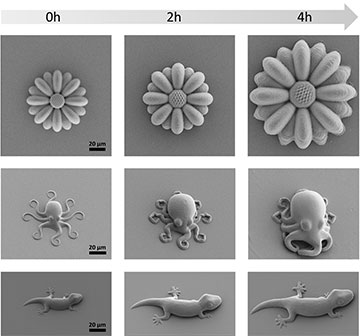Smart polymers with “life-like” properties. Due to dynamic chemical bonds, the micrometric 3D structures can grow eight-fold in just a few hours and harden. [Image: C. Spiegel (Heidelberg University). Adapted from Y. Jia et al., Adv. Funct. Mater. 2207826 (2022); CC BY 4.0] [Enlarge image]
Two-photon laser printing (2PLP), also known as direct laser writing, allows 3D printing to be performed at the micron and nanometer scale. Up to this point, most structures fabricated by 2PLP have been static and unable to change their form in response to external stimuli.
Now, a team of researchers in Germany has developed a new strategy for creating “living” 3D microstructures that can grow in size and harden at will (Adv. Funct. Mater., doi: 10.1002/adfm.202207826). It may prove useful for complex applications that require dynamic mechanical properties, such as those in microrobotics, microfluidics and biomedicine.
Finding the best ink for the job
The technique combines 2PLP with dynamic covalent chemistry, which allows for reversible bond breakage and formation autonomously or in the presence of a stimulus. In particular, the researchers designed an ink formulation such that a kind of dynamic covalent bond known as alkoxyamine units would be incorporated into the final printed structure. These alkoxyamine bonds could then be modified after printing to, say, add more monomers or change the cross-linking density.
“Conventional inks do not offer such features,” said senior author Eva Blasco, a professor at Heidelberg University, in a press release accompanying the research. “Adaptive materials containing dynamic bonds have a bright future in the field of 3D printing.”
Blasco and her colleagues identified ink components that would produce the so-called covalent adaptable microstructures (CAMs), then optimized the components’ ratios to produce the desired mix of “living” features and to print successfully. Specifically, they made sure that the ink would not require overly high laser powers or lead to slow printing speeds.
Dynamic, complex 3D structures
Next, the researchers used a commercial direct-laser-writing system with the novel ink formulation to fabricate complex CAMs (42×42×30 μm3), such as a sunflower, an octopus and a gecko. A femtosecond-pulsed, near-infrared laser was focused on a tiny point within the ink solution and, through two-photon polymerization, transformed it into a solid. Many pulses of light were used to build each 3D structure, and after the print was complete, the remaining material was removed.
With different chemical reactions, Blasco and her colleagues were able to successfully alter the mechanical properties of the CAMs post-print. For instance, a reaction called nitroxide-mediated polymerization chain extension introduced new monomers to the CAMs, causing them to grow eight-fold in just a few hours and harden while maintaining their shape.
“Manufacturing programmable materials whose mechanical properties can be adapted on demand is highly desired for many applications,” said Blasco.

